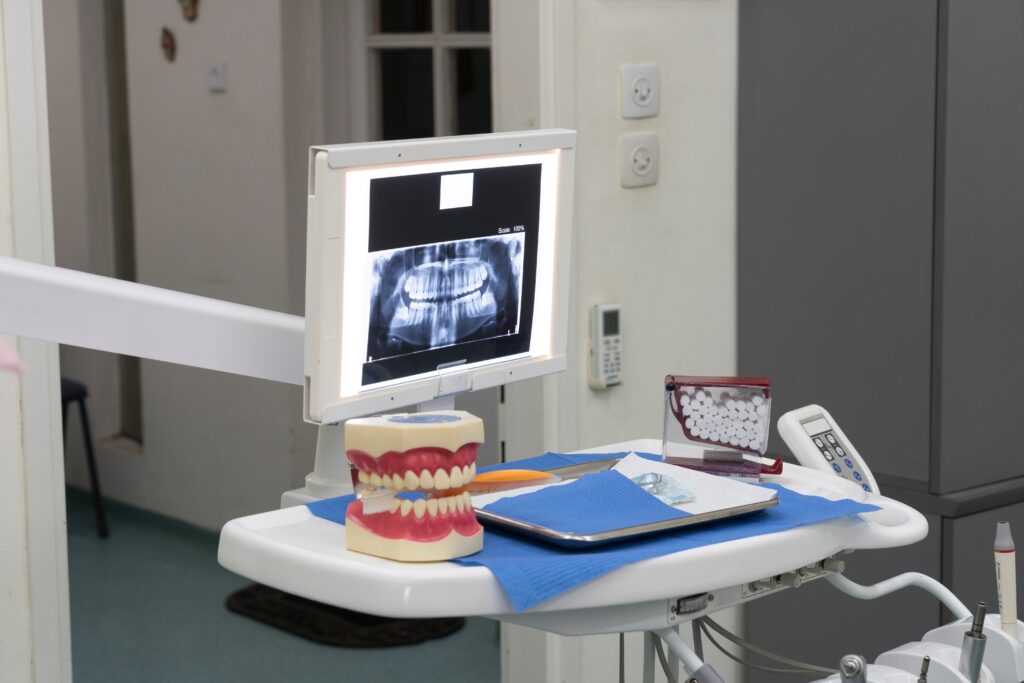Wisdom Tooth Removal Cost UK. A Complete Guide Wisdom teeth are the last molars to appear in the mouth, usually developing between …
What is a Cone Beam CT scan?
Cone beam CT scan (CBCT) has revolutionised dentistry by offering a comprehensive view of the teeth, jaws, and surrounding structures, including nerves, blood vessels, and soft tissues. This technology allows dentists to accurately assess the patient’s oral anatomy, enabling precise treatment planning and execution. This article will discuss the CBCT scan, its indications, preparation requirements, and its role in dental implants.

A cone beam CT (CBCT) scan is an advanced imaging technique that uses a cone-shaped X-ray beam to capture detailed, three-dimensional images of the oral and maxillofacial region. Unlike traditional CT scans, which use a fan-shaped X-ray beam, CBCT scanners rotate around the patient’s head, capturing a series of two-dimensional images that are then reconstructed by a computer to create a highly detailed 3D representation.
What's the difference between a CBCT scan and standard X rays?
While conventional dental X-rays remain a valuable diagnostic tool for assessing teeth and identifying different dental issues, they have inherent limitations in visualising comprehensive details of the oral and maxillofacial structures. Traditional X-rays capture flat, two-dimensional images, which can obscure certain anatomical features and make it challenging to accurately evaluate the jawbone and surrounding areas.
In contrast, CBCT scans generate highly-detailed three-dimensional images, enabling dentists to visualise the oral and maxillofacial region from various angles and perspectives. This 3D representation provides a complete understanding of the dental anatomy with superior imaging of vital structures such as nerves, blood vessels, and sinuses. CBCT scans help dentists to accurately measure the jawbone, teeth roots, and other anatomical structures. This is crucial for treatment planning, implant placement, and other dental procedures that require high accuracy. Furthermore, CBCT scans generally use low radiation doses, making them a safer option, especially for patients who require frequent imaging.
What are the indications for CBCT scan?
CBCT scans are widely used in various dental applications, including:
Dental implant planning: CBCT scans are invaluable for planning dental implants. They provide detailed information about jawbone density, quality, and volume, as well as the location of vital structures like nerves and sinuses.
Orthodontic treatment planning: CBCT scans can assist orthodontists in evaluating the position and alignment of teeth, jaws, and facial structures, aiding in developing effective treatment plans.
Endodontic evaluation: CBCT scans can be used to assess root canal anatomy. They provide a comprehensive view of the intricate root canal structure, helping to plan root canal treatments.
Temporomandibular joint (TMJ) assessment: CBCT scans can provide detailed TMJ images, helping dentists diagnose TMJ disorders.
Dental trauma evaluation: In cases of dental trauma or injury, CBCT scans can help dentists assess the extent of damage, identify fractures, and plan appropriate treatment strategies.
Dental anomalies and pathologies: CBCT scans can aid in the diagnosis and evaluation of various dental abnormalities, such as impacted teeth, cysts, and tumours, allowing for more effective treatment planning.
What is the role CBCT scans in dental implants
CBCT scans play a pivotal role in the successful placement of dental implants. They provide detailed three-dimensional images of the jawbone, allowing dentists to identify the optimal implant location by considering bone density, quality, and proximity to vital structures like nerves and sinuses. By combining CBCT scan data with advanced computer-aided design (CAD) software, dentists can create virtual 3D models of the patient’s jaw, enabling precise implant planning and the fabrication of surgical guides. This technology facilitates minimally invasive implant procedures, reducing patient discomfort and accelerating recovery times.
Furthermore, CBCT scans contribute to dental implant treatment by avoiding potential complications. These scans assess the condition and stability of dental implants, helping dentists identify and address complications that may require intervention.
How to prepare for a CBCT scan?
Proper preparation is essential to ensure a successful and accurate CBCT scan. These simple steps help to obtain high-quality images and minimise potential issues during scanning.
Remove metal objects, such as jewellery or hairpins, as they can distort the images.
Wear comfortable, loose-fitting clothing without metallic objects or zippers.
Inform your dentist if you are pregnant, as additional precautions may be required to minimise radiation exposure during the procedure.
Follow any instructions regarding medication, including whether to continue or discontinue specific medications before undergoing the scan.
Avoid any movement during the scan to prevent the blurring of images.
To ensure a safe and accurate scan, provide your complete medical history, including allergies.
Cone beam computed tomography (CBCT) scan has revolutionised dentistry, providing dentists with invaluable insights into the oral and maxillofacial region. This latest imaging technique offers detailed three-dimensional visualisations, enabling precise treatment planning, particularly in dental implants. CBCT scans enhance diagnostic accuracy, treatment outcomes, and patient safety by providing comprehensive information about the jawbone, teeth, and surrounding structures.
CBCT scans at The Harley Street Implant Centre
We only use the best imaging technology available to assist with your dental procedures. Speak with our lead dentist, Dr Anthony James, to discuss the role of CBCT scans in accurate diagnosis and precise treatment of your condition. If you have any further questions regarding how CBCT scans are utilised in planning your treatment, please do not hesitate to contact us.
IV Sedation Myths : 3 Of The Most Common Myths Debunked
For many patients, the most difficult part of getting dental implants is not the surgery itself but making the decision to seek …
Non Surgical Wisdom Tooth Extraction Recovery
Non Surgical Wisdom Tooth Extraction Recovery: A Harley Street Guide Recovering from a non-surgical wisdom tooth extraction is usually straightforward, but knowing …
Why We Built a High-End Dental Implant Clinic from Day One, And Why It Matters for Your Care
When people hear that we built a high end dental implant clinic on Harley Street, the first question they often ask is …



